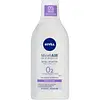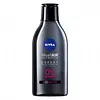What's inside
What's inside
 Key Ingredients
Key Ingredients

No key ingredients
 Benefits
Benefits

 Concerns
Concerns

 Ingredients Side-by-side
Ingredients Side-by-side

Water
Skin ConditioningPEG-40 Hydrogenated Castor Oil
EmulsifyingVitis Vinifera Seed Oil
EmollientPanthenol
Skin ConditioningGlycerin
HumectantSorbitol
HumectantDecyl Glucoside
CleansingPoloxamer 124
EmulsifyingPolyquaternium-10
Disodium Cocoyl Glutamate
CleansingCitric Acid
BufferingSodium Chloride
MaskingSodium Acetate
BufferingPropylene Glycol
Humectant1,2-Hexanediol
Skin ConditioningTrisodium EDTA
Phenoxyethanol
PreservativeWater
Skin ConditioningIsododecane
EmollientGlycerin
HumectantC15-19 Alkane
SolventCamellia Sinensis Leaf Extract
AntimicrobialVaccinium Myrtillus Fruit Extract
Skin ConditioningIsopropyl Palmitate
EmollientCaprylyl/Capryl Glucoside
CleansingCoco-Caprylate/Caprate
EmollientSodium Chloride
MaskingTrisodium EDTA
Sodium Hydroxide
BufferingBenzethonium Chloride
AntimicrobialPhenoxyethanol
PreservativeCI 60725
Cosmetic ColorantCI 61565
Cosmetic Colorant
 Reviews
Reviews

Ingredients Explained
These ingredients are found in both products.
Ingredients higher up in an ingredient list are typically present in a larger amount.
Glycerin is already naturally found in your skin. It helps moisturize and protect your skin.
A study from 2016 found glycerin to be more effective as a humectant than AHAs and hyaluronic acid.
As a humectant, it helps the skin stay hydrated by pulling moisture to your skin. The low molecular weight of glycerin allows it to pull moisture into the deeper layers of your skin.
Hydrated skin improves your skin barrier; Your skin barrier helps protect against irritants and bacteria.
Glycerin has also been found to have antimicrobial and antiviral properties. Due to these properties, glycerin is often used in wound and burn treatments.
In cosmetics, glycerin is usually derived from plants such as soybean or palm. However, it can also be sourced from animals, such as tallow or animal fat.
This ingredient is organic, colorless, odorless, and non-toxic.
Glycerin is the name for this ingredient in American English. British English uses Glycerol/Glycerine.
Learn more about GlycerinPhenoxyethanol is a preservative that has germicide, antimicrobial, and aromatic properties. Studies show that phenoxyethanol can prevent microbial growth. By itself, it has a scent that is similar to that of a rose.
It's often used in formulations along with Caprylyl Glycol to preserve the shelf life of products.
Chances are, you eat sodium chloride every day. Sodium Chloride is also known as table salt.
This ingredient has many purposes in skincare: thickener, emulsifier, and exfoliator.
You'll most likely find this ingredient in cleansers where it is used to create a gel-like texture. As an emulsifier, it also prevents ingredients from separating.
There is much debate on whether this ingredient is comedogenic. The short answer - comedogenic ratings don't tell the whole story. Learn more about comegodenic ratings here.
The concensus about this ingredient causing acne seems to be divided. Research is needed to understand if this ingredient does cause acne.
Scrubs may use salt as the primary exfoliating ingredient.
Learn more about Sodium ChlorideWe don't have a description for Trisodium EDTA yet.
Water. It's the most common cosmetic ingredient of all. You'll usually see it at the top of ingredient lists, meaning that it makes up the largest part of the product.
So why is it so popular? Water most often acts as a solvent - this means that it helps dissolve other ingredients into the formulation.
You'll also recognize water as that liquid we all need to stay alive. If you see this, drink a glass of water. Stay hydrated!
Learn more about Water